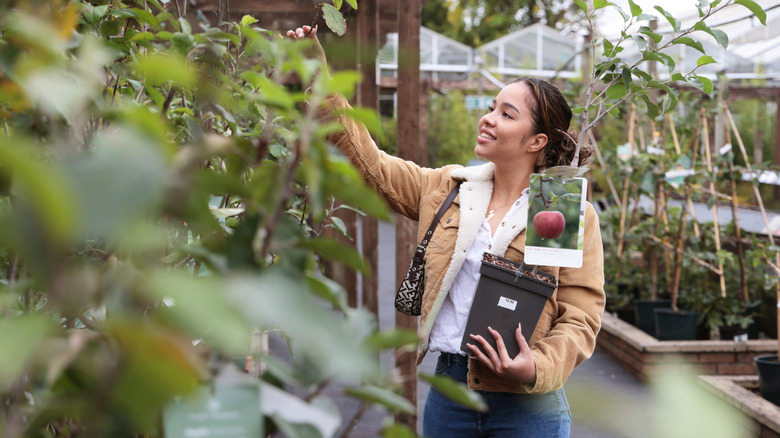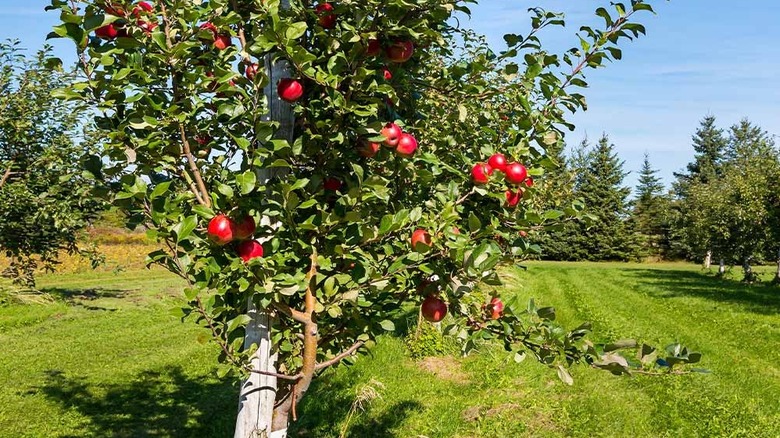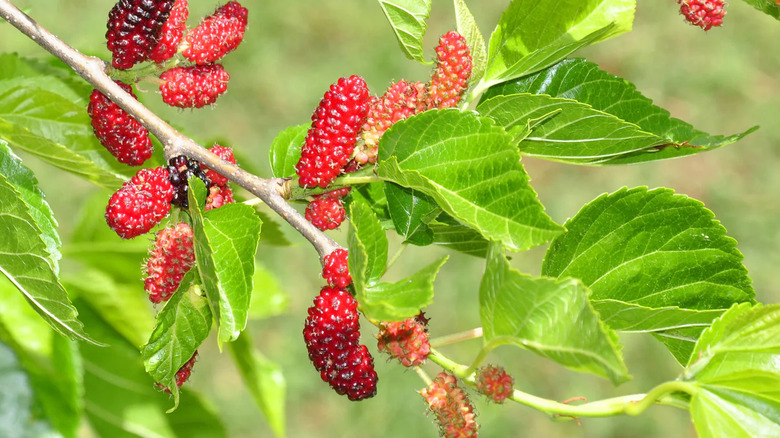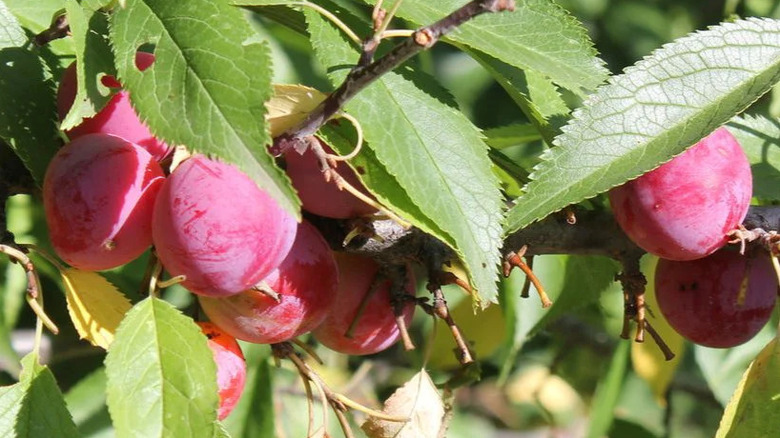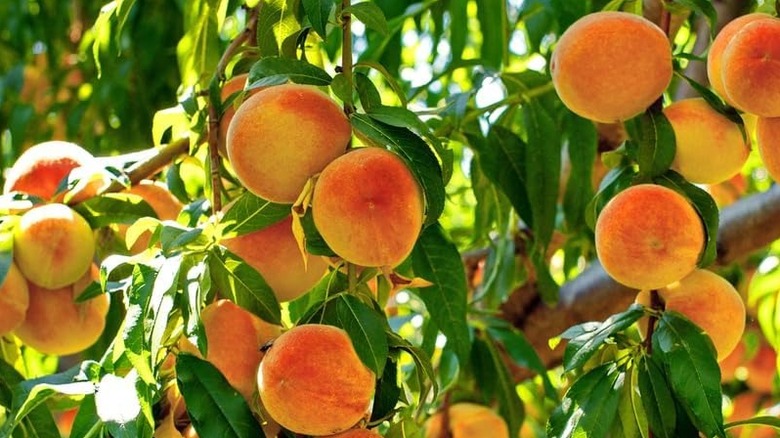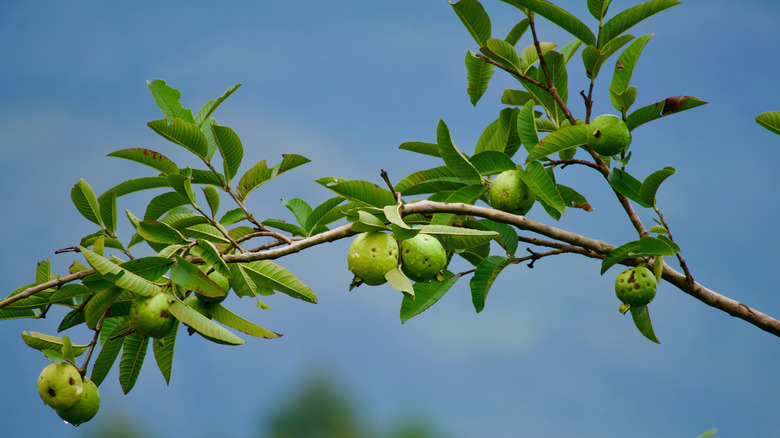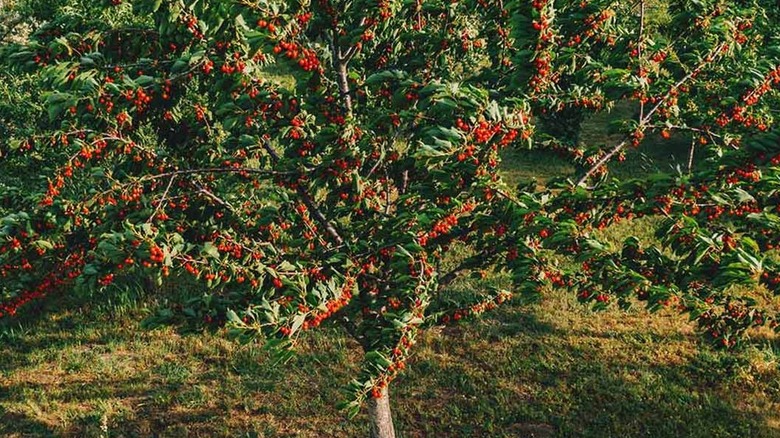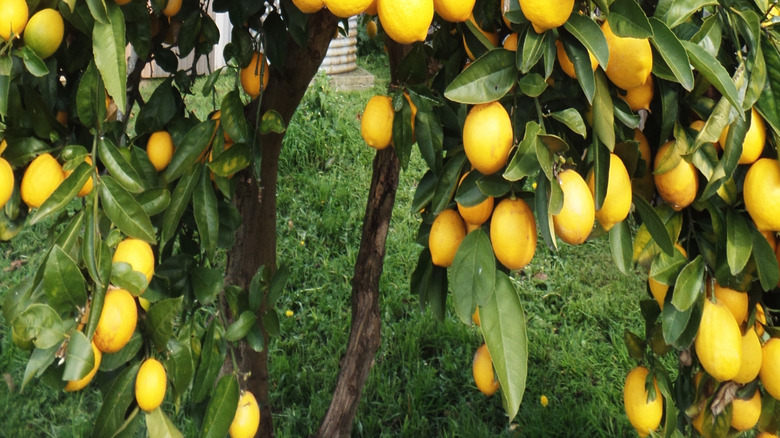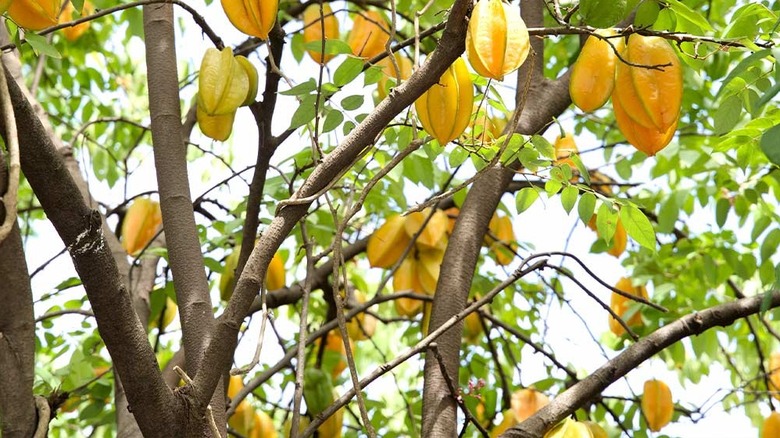Fast-Growing Fruit Trees You'll Want To Plant In Your Yard
We may receive a commission on purchases made from links.
Planting fruit trees in your yard adds beautiful accents to your landscape and, hopefully, bountiful fruit harvests to match. However, the waiting period can be frustrating since fruit trees grown from saplings or seeds usually take years to develop. Fortunately, you can shorten this time frame by selecting fast-growing fruit trees that will bear and mature in a surprisingly short period compared to other cultivars and species.
Below are fruit tree species you should consider planting in your yard if you're after (relatively) quick results. These species are either inherently rapid-growing, a specific cultivar, or a dwarf-sized version of a larger fruit tree. Keep in mind that some of these trees will grow faster than others, depending on where you live. The closer your environment matches a fruit tree's native homeland, the more likely it will thrive and grow quickly. For instance, a tropical fruit tree is unlikely to grow at a rapid rate and bear fruit fast in a cold climate, even if it's a naturally fast-growing species. The same can be said for fruit trees that need a chill period before they bear. If outdoor temperatures don't fall below freezing for several hundred hours, many temperate fruit trees can struggle to break out of dormancy and start their fruit-bearing cycle.
Another factor to keep in mind is that smaller trees tend to mature sooner. They don't have to grow as tall before being able to support fruit. Since fast-growing species increase in height by at least a foot a year, expect a dwarf or semi-dwarf sapling to quickly reach a mature size, ideal if you're eager to learn how to design a fruit orchard in your yard and get yields as soon as possible. Itching to get started? Without wasting any more time, let's jump into some of the fastest-growing fruit trees to plant in your yard.
Many dwarf apple tree cultivars are fast-growing and ideal for home orchards
Apple trees are among the most popular types of fruit trees, and there are numerous cultivars as a result. Many cultivars also come in different-sized trees: dwarf, semi-dwarf, or standard-sized. Dwarf trees grow about a foot a year and reach maturity at around 8 to 10 feet tall. If your soil is good, some varieties might not even need fertilizer to speed up their growth. Saplings from nurseries are usually already a year or two old, and if you purchase a dwarf cultivar, it could start to bear fruit within a couple of years.
The biggest benefit of planting an apple tree is that you can potentially grow your favorite apple variety at home. It might be a type that isn't always available at your local grocer. Additionally, if you find your desired cultivar in dwarf or semi-dwarf size, it'll easily fit in a standard-sized yard. There are several heirloom apple trees that thrive in homegrown gardens, though you'll have to double-check your USDA growing zone before selecting one. Most apple trees grow well in zones 5 through 8. If you live outside of those zones, they may not grow as quickly as expected. Additionally, the rootstock on your dwarf apple might affect how rapidly it grows. Dwarf apple trees can also require a little more care than standard-size cultivars. For instance, they may need to be supported with a trellis.
Red mulberry trees require a minimum of care, grow a foot or more per year, and yield bountiful harvests
Red mulberries have a reputation for growing like weeds, making them a great choice as a fast-growing fruit tree. They advance around a foot per year and are mature at around 6 to 10 feet tall. However, some sources even report them growing as much as 10 feet a year. It's important to know they can grow far beyond their "mature" height but are controllable with routine pruning. Generally, red mulberries start to fruit at around 4 years old, but the harvest gets more bountiful as the tree becomes larger.
Not only do red mulberry trees grow startlingly fast, but they can also produce up to 10 bushels of fruit, which may seem overwhelming to an amateur gardener. Fortunately, you only have to worry about trimming and harvesting a single red mulberry tree. This species is self-pollinating, so it only takes a single sapling in your yard to reap the benefits. You also have a lot of control over their size as long as you cut their branches every 2-3 years. If this sounds like too much maintenance, you can also look into sourcing a dwarf mulberry cultivar.
Wild plum grows rapidly and tolerates a wide range of soils, bearing delicious fruit in the fall
The best combination of characteristics in an ideal fruit tree for home orchards is one that is fast-growing and small in stature. Wild plums fit this bill, progressing as quickly as 2 to 5 feet per year and being fully grown at around 10 feet tall. Since these plants are native to much of the central United States, they thrive in most USDA growing zones. Even though they need "chill hours" like most fruiting trees, warmer states like Florida and Georgia have cultivated hybrid varieties (like 'Gulfbeauty') that need almost half the amount of chill hours.
In addition to being one of the fastest-growing fruit trees, wild plums have ornamental value, too. In the springtime, they bloom with fragrant white blossoms, though people are divided on whether it's a pleasant smell, too sweet, or nonexistent. The only drawback is that the flowers can bloom prematurely when the weather starts warming up. If another frost comes, they'll freeze and not produce fruit. This can hinder your harvest, but you can help protect your young wild plum by applying mulch or placing a windbreak nearby.
Dwarf peach trees can give you generous yields within a few short years
Homegrown peach fruit trees effortlessly meet the criteria of a fast-growing plant. Certain cultivars, like 'Elberta' peaches, grow up to 3 feet a year, going from seedlings to fully grown trees in 3 or 4 short years. Other small dwarf peach tree varieties are only 4 feet tall, reaching maturity even faster. What's more, peaches do not drop the ball when it comes to producing fruit; even dwarf varieties can yield over 50 pounds a year, which equates to about one bushel.
Aside from flourishing rapidly, homegrown dwarf peaches have another perk — you have a lot more control over how many pesticides are in them. In the 2024 Shopper's Guide to Pesticides in Produce, the Environmental Working Group reported peaches as the fifth most contaminated produce item. Store-bought peaches can still have remnants of these pesticides and fungicides, and the chemicals have been linked to health problems in people. Growing your own peach trees will allow you to try eco-friendly ways to keep bugs out of your garden and utilize less harmful pesticide solutions, such as a copper spray and lime sulfur.
Guava trees grow uncommonly fast in warm climates and can bear fruit within a few seasons
Guavas are good choice for warm climates because they have very different preferences from the most traditional fruit trees. They are a tropical species, and most guava varieties don't need chill hours to produce fruit. In the right conditions, young trees can bear within 3 years of planting. While other fruit trees need freezing temperatures to spark their fruit production ability, guavas don't like weather below 60 degrees Fahrenheit. They thrive in a few USDA growing zones north of Florida but need extra insulation or must be brought indoors during the winter.
These tropical fruits may need a little extra caretaking in winter. They can be blown down by strong winds if allowed to grow taller than 10 feet, and so should be pruned and maintained at a small but healthy 6-foot height. The younger the tree, the less resilient it is against wind and extreme weather. However, a small stature will make it easier to transport (if it's in a pot) when dangerous cold fronts and storms are en route. Another positive aspect of growing guava trees is there's no need to cross-pollinate them with other guavas. A single tree needs only itself to fertilize and provide sweet but tangy fruits. Unfortunately, guavas are not one of the fast-growing fruit trees you can grow from seed (as they won't grow true to type), so you'll need to source a young tree from a nursery.
Tart cherry trees mature quickly and can start producing cherries after 3 years
Most sweet and tart cherry tree cultivars mature around 10 to 15 feet. There are several hundred varieties of cherries, created over centuries of raising and harvesting these fruits. Most cherry trees grow quite quickly, at about 1 to 2 feet per year, though certain types are especially renowned for being fast-growing. Sweet cherry trees take about 4-7 years to reach fruit-bearing age, but tart cherries only take 3-5 years. One of the most popular tart cherries is the Montmorency, which bears fruit at a height shorter than average: around 8 feet tall.
Most sour and tart cherry cultivars are self-fruiting, including the Montmorency. Even though this fruit tree bears without a companion, you may want to plant more than one to get an even more prolific harvest going with some cross-pollination. This decision is open-ended: If you're planning on planting fruit trees even though you don't have much room, opt for a single cherry tree — if you have lots of space, double up for enhanced pollination and bigger yields. Keep in mind that tart cherries aren't usually eaten raw. They taste acidic when plucked straight from the tree and need to be made palatable through baking, cooking, preserving, or fermenting.
Meyer lemons can bear fruit at just 5 feet tall, and within a couple of growing seasons
Several citrus-bearing fruit trees are notoriously quick to mature. Meyer lemon trees are a hybrid of mandarin oranges and lemons, and dwarf varieties are big enough to produce fruit at only 5 or 6 feet tall. Growing Meyer lemon trees from seed is not recommended, as the resulting trees probably won't be true to type. You can buy saplings from places like The Home Depot (which sells the Bell Nursery Improved Meyer Lemon Tree ) which are around 1.5 feet tall, and many people report Meyer lemon trees growing large enough to fruit within a year of purchasing.
Meyer lemons have several perks, ranking them above other homegrown fruit trees. Like many citrus trees, they are self-fruiting. They're also "everbearing," meaning they'll produce several harvests in a year. Meyer lemons prefer warmer climates, but if you live somewhere with freezing winters, you're in luck. Meyer lemons will also grow in large pots as well as they do in natural soil. Here are some tips and tricks to keep your potted citrus trees thriving over the years. Container planting Meyer lemon trees also keeps them at a more manageable size so they can be moved inside during inclement weather.
Star fruit trees grow rapidly and produce fruit within reaching distance
Star fruits from carambola fruit trees are becoming increasingly popular in American grocery stores, though other cultures have been cultivating them for centuries. They grow rapidly in warm southern climates, maturing within 7 to 12 years and reaching impressive heights of up to 33 feet, though routine trimming can keep them at between 6 to 12 feet. Expect fruit to start popping up as soon as a year, with warmer USDA growing zones getting even better and faster results.
This fruit tree species is also everbearing and produces 10 to 40 pounds of fruit throughout the year. Fruit production really takes off during late summer, early fall, and throughout winter. Another benefit of these trees for your yard is that they grow fruits in their mid-canopy area. Their mid-canopy is only 3 to 7 feet high, putting most of the harvest within reaching distance. Star fruit trees also drop their fruits when they're fully ripe and ready to consume, making them even more accessible.
